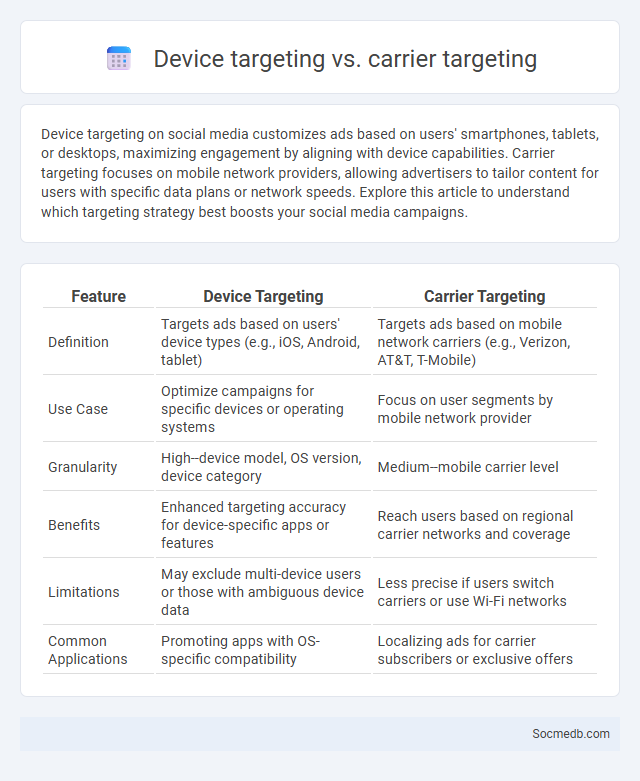
Photo illustration: Device targeting vs Carrier targeting
Device targeting on social media customizes ads based on users' smartphones, tablets, or desktops, maximizing engagement by aligning with device capabilities. Carrier targeting focuses on mobile network providers, allowing advertisers to tailor content for users with specific data plans or network speeds. Explore this article to understand which targeting strategy best boosts your social media campaigns.
Table of Comparison
| Feature | Device Targeting | Carrier Targeting |
|---|---|---|
| Definition | Targets ads based on users' device types (e.g., iOS, Android, tablet) | Targets ads based on mobile network carriers (e.g., Verizon, AT&T, T-Mobile) |
| Use Case | Optimize campaigns for specific devices or operating systems | Focus on user segments by mobile network provider |
| Granularity | High--device model, OS version, device category | Medium--mobile carrier level |
| Benefits | Enhanced targeting accuracy for device-specific apps or features | Reach users based on regional carrier networks and coverage |
| Limitations | May exclude multi-device users or those with ambiguous device data | Less precise if users switch carriers or use Wi-Fi networks |
| Common Applications | Promoting apps with OS-specific compatibility | Localizing ads for carrier subscribers or exclusive offers |
Introduction to Digital Advertising Targeting Methods
Digital advertising targeting methods leverage user data, behavioral patterns, and demographic information to deliver personalized content on social media platforms. Techniques such as interest targeting, lookalike audiences, and geo-targeting enable advertisers to reach your ideal customers with precision and enhance campaign effectiveness. Understanding these methods allows your brand to optimize ad spend and maximize engagement in a competitive digital landscape.
What is Device Targeting?
Device targeting in social media advertising allows you to customize your campaigns based on the specific devices your audience uses, such as smartphones, tablets, or desktops. This strategy helps optimize ad delivery by tailoring content and user experience to different screen sizes and operating systems, improving engagement and conversion rates. Implementing device targeting ensures your ads reach your audience on the most relevant platforms, maximizing the impact of your marketing efforts.
Exploring Carrier Targeting in Advertising
Carrier targeting in social media advertising leverages mobile network data to deliver precise, relevant ads based on the user's mobile carrier. Brands can optimize campaign performance by tailoring content to specific carrier demographics, usage patterns, and geographic locations. This strategy enhances engagement rates and maximizes return on ad spend by reaching the most responsive audiences through platforms like Facebook, Instagram, and Snapchat.
Understanding Audience Targeting
Understanding audience targeting on social media involves analyzing demographic data such as age, gender, location, and interests to craft personalized content that resonates with specific user groups. Leveraging advanced algorithms and machine learning enables marketers to predict user behavior and optimize ad placements for higher engagement and conversion rates. Utilizing tools like Facebook Audience Insights and Twitter Analytics helps refine targeting strategies, ensuring marketing efforts reach the most relevant and engaged audience segments.
Key Differences: Device vs Carrier vs Audience Targeting
Device targeting focuses on reaching users based on the specific devices they use, such as smartphones, tablets, or desktops, optimizing ad formats and user experience accordingly. Carrier targeting narrows the audience by mobile network providers, enabling marketers to serve ads relevant to users on specific carriers, which is crucial for regional campaigns and network-specific promotions. Audience targeting leverages demographics, interests, behaviors, and social connections to deliver personalized content, ensuring higher engagement by addressing users' preferences and online activity patterns.
Pros and Cons of Device Targeting
Device targeting in social media enables marketers to optimize ad delivery by tailoring content to specific devices like smartphones, tablets, or desktops, enhancing user experience and engagement. It allows for precise audience segmentation and improves campaign performance by leveraging device-specific behaviors and usage patterns. However, device targeting can lead to challenges such as increased complexity in campaign management, potential privacy concerns, and the risk of alienating users on less targeted or older devices.
Benefits and Challenges of Carrier Targeting
Carrier targeting in social media advertising allows businesses to tailor campaigns based on users' mobile network providers, enhancing ad relevance and improving engagement rates by delivering context-specific content. This method increases return on investment (ROI) through precise audience segmentation but poses challenges such as data privacy concerns and potential limitations due to carrier-specific restrictions or variable user data accuracy. Navigating these issues requires balancing targeted marketing benefits with compliance to regulations like GDPR and maintaining consumer trust.
Advantages of Audience Targeting Strategies
Audience targeting strategies in social media enable businesses to deliver personalized content that increases engagement and conversions by reaching the most relevant users based on demographics, interests, and behaviors. These precision marketing techniques improve ad spend efficiency by minimizing waste and maximizing return on investment (ROI). Enhanced customer insights gathered through targeting tools allow for continuous optimization of campaigns, leading to sustained growth and brand loyalty.
When to Use Each Targeting Method
Social media advertising offers various targeting methods such as demographic, behavioral, interest-based, and custom audience targeting, each suited for specific campaign goals. Demographic targeting is ideal for reaching broad groups by age, gender, or location, while behavioral and interest-based methods focus on users' online activities and preferences, perfect for niche audiences. Your choice depends on the campaign objective, ensuring you reach the right audience at the right time for maximum engagement and conversions.
Conclusion: Choosing the Right Targeting for Your Campaign
Selecting the right targeting for your social media campaign maximizes engagement and boosts ROI by reaching the most relevant audience segments. Precise targeting options, such as demographics, interests, and behavior, help tailor your messaging to align with user preferences and increase conversion rates. Your campaign's success depends on continuously analyzing performance data and refining targeting strategies to adapt to evolving market trends and audience insights.
 socmedb.com
socmedb.com